 BETHUNE
BETHUNE
IN
SPAIN

Here is Madrid, but never will it be fascist!

Through discipline the Republic defends itself.

BETHUNE
IN
SPAIN
Roderick Stewart and Jess Majada

Roderick Stewart and Jess Majada 2014
ISBN 978-0-7735-4383-6 (cloth)
ISBN 978-0-7735-9226-1 (ePDF)
ISBN 978-0-7735-9227-8 (ePUB)
Legal deposit second quarter 2014
Bibliothque nationale du Qubec
Printed in Canada on acid-free paper that is 100% ancient forest free
(100% post-consumer recycled), processed chlorine free
McGill-Queens University Press acknowledges the support of the Canada Council for the Arts for our publishing program. We also acknowledge the financial support of the Government of Canada through the Canada Book Fund for our publishing activities.
Library and Archives Canada Cataloguing in Publication
Stewart, Roderick, 1934, author Bethune in Spain / Roderick Stewart and Jess Majada.
Includes newspaper articles, printed interviews, personal letters, and reports.
Includes bibliographical references, filmography and index.
Issued in print and electronic formats.
ISBN 978-0-7735-4383-6 (bound).
ISBN 978-0-7735-9226-1 (ePDF).
ISBN 978-0-7735-9227-8 (ePUB)
1. Bethune, Norman, 18901939. 2. Bethune, Norman, 18901939 Travel Spain. 3. Spain History Civil War, 19361939 Participation, Canadian. 4. Spain History Civil War, 19361939 Medical care. 5. Spain Description and travel. 6. Physicians Canada Biography. 7. Philanthropists Canada Biography. 8. Communists Canada Biography. I. Majada Neila, Jess, author II. Title.
R464.B4S743 2014 617.092 C2014-900869-4
C2014-900870-8
This book was designed and typeset by studio oneonone in Minion 11/14.2

CONTENTS

Evacuate Madrid.

PREFACE
Jess Majada Neila, writer and retired teacher of Spanish literature, lives near the city of Mlaga in southern Spain. His principal interest, which has led him to write books and to design pictorial exhibitions, is the greatest tragedy of the Spanish Civil War: the flight of 100,000 unarmed civilians from Mlaga along the Mediterranean coastal road to Almera, 200 kilometres to the east, in February 1937. Under attack by Spanish Nationalist land, air, and sea forces, and pursued by Italian Blackshirts, many of the refugees were slaughtered.
In 2006, in response to Jess suggestion, the University of Salamanca invited me to participate in a round table as part of Las Brigadas Internacionales: 70 aos de Memoria Histrica, a conference held to mark the seventieth anniversary of the outbreak of the Spanish Civil War. During a conversation at the conference Jess suggested that we collaborate on a book describing Bethunes achievements in Spain. The model he proposed was my The Mind of Norman Bethune (1977), in which I outlined Bethunes life using his own writings and photographs that others had taken of him. When Jess pointed out that he had various unpublished photographs of Bethune, I became interested in his idea. Many of Bethunes writings in Spain had appeared in my book and, later, in Larry Hannants The Politics of Passion: Norman Bethunes Writing and Art (1998). However, during our research for the then-unpublished Phoenix: The Life of Norman Bethune, Sharon Stewart and I had come upon unpublished letters and documents written by Bethune during his seven-month stay in Spain. What Jess and I began to discuss that day evolved into this book, which contains the known writings of Bethune in Spain and a selection of photographs, including many published for the first time. Its first, Spanish, edition was published in Madrid by Fundacin Domingo Malagn on 12 November 2009, the seventieth anniversary of Bethunes death. The publication of the present English-language edition in 2014 marks the seventy-fifth anniversary of Bethunes death. We offer it in tribute to Norman Bethune, a Canadian who was truly a doctor without borders.
RODERICK STEWART
Richmond Hill, Ontario
EDITORIAL NOTE
Excerpts from Bethunes writings and radio broadcasts are reproduced in this volume as they appear in their originally published or manuscript form; Bethunes punctuation and spelling have been preserved, and omitted words have been supplied in square brackets. Some minor errors of spelling have been silently corrected.
On the way to Almera they machine-gunned us: my parents covered us with their bodies. Nothing happened to us but there were victims on the highway. Of course, I saw some of them. On the morning of my birthday, an Italian seaplane bombed us in the town of Motril. I remember it very well because one of its bombs hurled my uncle and me into the air. Luckily we were in a recently ploughed field and the soft earth cushioned us.
Rosendo Fuentes, survivor of the flight from Mlaga to Almera
There was such great fear that if they made out a crow in the distance they thought it might be a plane and fled in terror. I have never forgotten that woman who, wounded by a shell, in the middle of a pool of blood, was suckling and embracing her two-month-old son.
Miguel Escalona Quesada, survivor of the flight from Mlaga to Almera

BETHUNE
IN
SPAIN

Refugees on the MlagaAlmera road. (Hazen Sise. National Film Board of Canada)

Spain, January 1937.

THE ROOTS
Norman Bethune always believed that his destiny was profoundly influenced by his ancestry: I come of a race of men, he wrote, violent, unstable, of passionate conviction and wrong-headedness, yet with it all a vision of truth and a drive to carry them on to it even though it leads, as it has done in my family, to their own destruction. Who, then, were this race of men called Bethune?
The name derives from Betunia, a region in the Roman province of Gaul (modern northwest France), and first appeared in a ninth-century document that referred to Robert, first lord of Bthune and Richebourg, and protector of the Church of Arras. Nearly 400 years later, not long after the first Bthune arrived in Scotland from the continent, various descendants rose to prominence as landowners, clergymen, and practitioners of medicine. Among them was Angus (b. 1540), first in a hereditary line of physicians appointed to serve the noted clan McLeod of Dunvegan on the Isle of Skye.
Next page

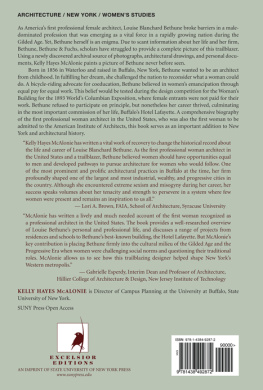
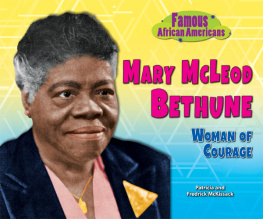

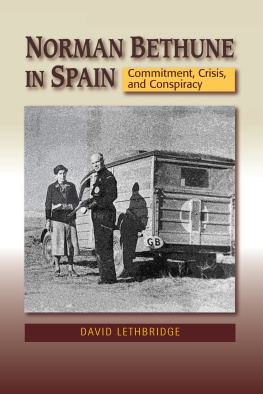

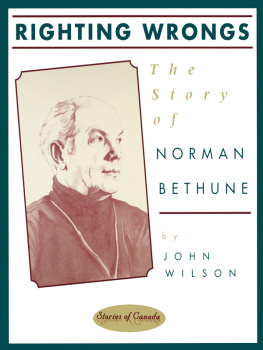
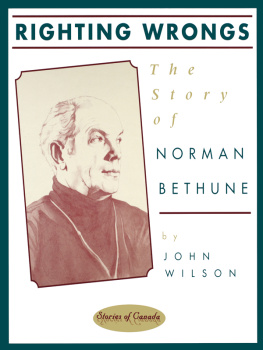
 BETHUNE
BETHUNE





